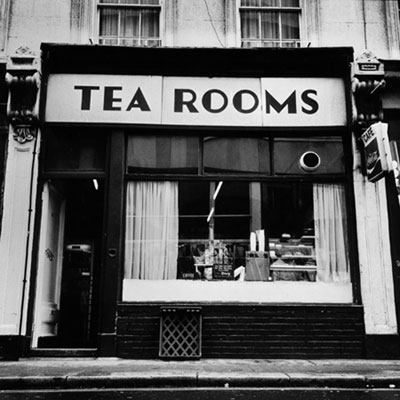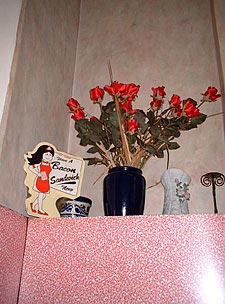This website uses cookies
This website uses cookies to enable it to function properly and to analyse how the website is used. Please click 'Close' to accept and continue using the website.






November 2002 - The Tea Rooms, London WC1
The Tea Rooms in Museum Street is a kind of evanescent EveryCafe most notable for its refraction of two previous centuries of cafe architecture: 19C Lyons Tea House hall and 30s Milk Bar.
The Zita Snack Bar round the corner (at 232 Shaftesbury Ave) offers a scent of Mid Century Modern Espresso bar, but the Tea Rooms’ yellowing exterior 40s signage offset by a large jolly green deco typeface almost makes it seem even older. Within, it’s wall-to-wall carmine mosaic Formica retains a quintessential, poignant quality of lost English drabness. Pure Pinter for now people!
The rows of little utility pews, classic steaming Gaggia machine and the laminate table tops all accent what Harry Hopkins’ in his social study of the 40s and 50s ‘The New Look’ (Secker and Warburg 1964) saw as a new architectural idiom where: “stark and strong…the alloys and the plastics, bright, sterile, precision machined, seemed to belong not merely to a different period but to a totally different universe…”
Before the 70s high street rash of injection-moulded burger joints and the irruption of 90s’ US coffee shops, Britain was blessed with thousands of these vintage Formica ‘classic’ cafes. They exemplified the ‘Contemporary’ look of the Festival of Britain. A move from a desperate and dingy 40s era into a fresh sense of the future accenting a stripped-down, primary decorative art. Moving on from the all-white uniformity of Modern styling, the temperate Scandinavian origins of the New Look were manifest in materials like vinyl, plywood, synthetic laminates and chrome. All became especially evident in kitchen interiors and functional commercial spaces like cafés as flush finishes, vibrant laminated surfaces and colourful table ceramics become popular.
These yearning spaces galvanised post-war British cultural life. In his study of 50 British Architecture ‘Building A Better Tomorrow’ Robert Elwall notes: ‘The vogue for coffee bars…provided a whiff of exotic cosmopolitanism and gave eclecticism free rein.’ Cafes acted as incubators for a generation of postwar writers, artists, designers, musicians and sexual subculturists. They added colour to Britain’s post-war social, artistic and commercial scene. Without them the 60s might never have been so seismic.
The Parisian café is justly held in high esteem. So too the US diner with its heritage of candy-colorized Americana. But the British cafes – those purlieus of Proustian possibility – were never given their due. Throughout the 80s & 90s cafes like The Tea Rooms fell into disuse. Largely despised, dishonoured and forgotten, most are now vanishing in a welter of redevelopment and refits, brutally Starbuck-ed by the big drinks chains. Too often dismissed as ‘greasy spoons’, we should laud the faded attractions of the authentically forlorn caff. The last remaining ones – with their utility aesthetic and occasional Mid Century Modern detailings – are little gems of British vernacular high street commercial design.
Adrian Maddox runs www.classiccafes.co.uk and is the author of an extensive forthcoming illustrated study of the secret life and times of the great British ‘classic’ cafe to be published in early spring 2003.
Look for past Buildings of the Month by entering the name of an individual building or architect or browsing the drop down list.

Become a C20 member today and help save our modern design heritage.